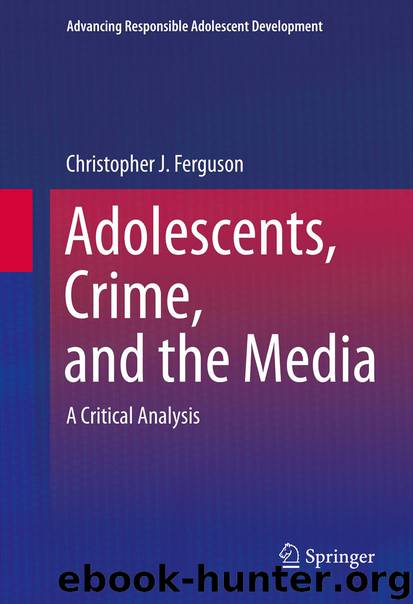Adolescents, Crime, and the Media by Christopher J. Ferguson

Author:Christopher J. Ferguson
Language: eng
Format: epub
Publisher: Springer New York, New York, NY
6.4 Uncertainty Develops in the 1980s
It would certainly be untrue to suggest that the causal hypothesis of television violence lost popularity in the 1980s. Yet, it became increasingly evident that studies of television violence continued to labor under difficulties with methodology, problems developing valid aggression measures and inconsistent results that had plagued such studies in the 1960s and 1970s. Several major studies were conducted in the 1980s in order to try to bolster the causal argument of television violent effects, but all were subsequently found to have glaring problems and results that were inconsistent. Perhaps of greater concern, inconsistencies, weak results, and methodological limitations were oftentimes covered up by study authors in an effort to promote an increasingly alarmist causal position (Freedman, 2002).
One issue that was raised by some critics of the causal view of television violence and aggression was that varying nations that shared similarly violent television, had wildly different violent crime rates and patterns. Specifically, although violent crimes spiked in the 1980s and early 1990s in the USA, violent crime spikes remained absent in other industrialized nations with violent media such as Western Europe, Canada, and Japan. Heusmann and Eron (1986) attempted to address this issue by examining the link between violent television viewing in aggression cross-nationally. Children in the USA, Poland, Finland, Israel, Australia, and the Netherlands were followed for 3 years. Aggression was once again measured using peer-nominated aggression. In this study, the link between television violence and aggressive behavior, once examined using multiple regression, proved unreliable, demonstrating significance only for American girls, and Israeli city children (but not children in an Israeli kibbutz), yet not for boys in the USA, girls in Poland or Finland, or children of either gender in Australia, the Israeli kibbutz, or the Netherlands (Moeller, 2001; Wiegman & Kuttschreuter, 1992). The authors, perhaps disappointed with these results, then formed an odd composite measure by combining television violence exposure with a personality measure regarding interest in aggressive role models. As such the predictor variable is no longer television violence exposure, but an odd composite measure that is difficult to interpret. Boys in Finland and Poland showed a significant relationship between aggression and this odd composite measure of television exposure and identification with more aggressive role models, but tellingly showed no correlation between aggression and television violence exposure itself. As such the results from the current study are inconsistent, but overall offer little support for the hypothesis that television violence causes aggression. Tellingly the Dutch scholars involved in the study appear to have pulled out of the study, given concerns over the conclusions made by Heusmann and Eron (1986). The Dutch authors published their results separately (Wiegman & Kuttschreuter, 1992).
More broadly, an examination of violence rates across countries notes that other nations such as Canada, Japan, England, Finland, Australia, etc., which share our rates of violent media consumption (as Heusmann & Eron, 1986 agree), have widely different violent crime rates, and even within a single country such as the USA, different ethnicities experience much different crime rates (World Health Organization, 2002).
Download
This site does not store any files on its server. We only index and link to content provided by other sites. Please contact the content providers to delete copyright contents if any and email us, we'll remove relevant links or contents immediately.
The Art of Coaching Workbook by Elena Aguilar(48059)
Trainspotting by Irvine Welsh(20052)
Twilight of the Idols With the Antichrist and Ecce Homo by Friedrich Nietzsche(17705)
Fangirl by Rainbow Rowell(7832)
Periodization Training for Sports by Tudor Bompa(7327)
Change Your Questions, Change Your Life by Marilee Adams(6639)
This Is How You Lose Her by Junot Diaz(5768)
Grit by Angela Duckworth(4735)
Red Sparrow by Jason Matthews(4663)
Asking the Right Questions: A Guide to Critical Thinking by M. Neil Browne & Stuart M. Keeley(4573)
Paper Towns by Green John(4169)
Room 212 by Kate Stewart(4102)
Ken Follett - World without end by Ken Follett(3972)
The Sports Rules Book by Human Kinetics(3586)
Housekeeping by Marilynne Robinson(3401)
The Motorcycle Diaries by Ernesto Che Guevara(3332)
Introduction to Kinesiology by Shirl J. Hoffman(3299)
Exercise Technique Manual for Resistance Training by National Strength & Conditioning Association(3291)
Double Down (Diary of a Wimpy Kid Book 11) by Jeff Kinney(3272)
